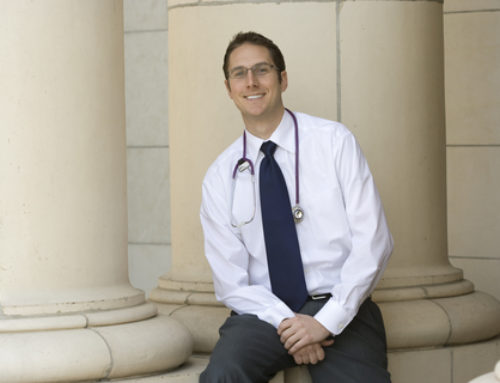“It takes a lot of courage to release the familiar and seemingly secure, to embrace the new. But there is no real security in what is no longer meaningful. There is more security in the adventurous and exciting, for in movement there is life, and in change there is power.”
— Allen Cohen
The beginning of the year is often a time when we reflect on where we have come from and where we want to go in both our personal lives and in our professional careers. This is also often a time of knee-jerk resolutions or life changes that are often abandoned over time because they were either too difficult to achieve or they were not reasonable.
Have you ever found yourself saying any of the following phrases to yourself at work?
- “I have to get out of here.”
- “I can’t do this anymore.”
- “This is not working for me.”
As a physician, you may find yourself thinking such thoughts, but because of the nature of what you do and your life circumstances, it is often very difficult to act on them. Does there come a time when a physician should move on, or even get out of the profession? When is it a good idea to make a change and when is it not?
The first thing to realize about thoughts of moving on is that they are sometimes the result of burnout.
Kernan Manion, MD, is a psychiatrist from North Carolina and a physician coach. He provides people with services and education to help them deal with “disabling” occupational stress, wear-down and burnout, and helps them make essential changes to improve their work lives and redesign their careers.
Dr. Manion says that burnout can cause physicians to distance themselves from patients, staff and even family, and can seriously diminish productivity, mental acuity and physical energy. “Emotional exhaustion” can also result. He adds that burnout is very common, with studies showing that from 30 percent to as much as 70 percent of physicians, nurses and therapists report some prominent element of burnout. (For more information, go to his site at www.worklifedesign.org)
The “pain” causing the burnout often leads to thoughts of job or career change in the hopes of altering the condition and returning to a more fulfilling life. “The thing that drives people to change is almost always pain, in the form of dissatisfaction or misery or anguish. Something is making us crazy,” Dr. Manion says.
Dr. Manion says that physicians who are looking for change need to step back and look at what is happening to them. They must ask themselves a series of questions:
- Why am I wanting to make this change?
- What is causing this pain?
- What am I longing for?
- What is holding me back?
“They need to define what is creating their dissatisfaction and where it is coming from,” Dr. Manion said. He added that they must determine the sources of dissatisfaction not only in their professional lives but in their personal lives as well, because dissatisfaction and pain can be diffuse, with stress from one area of life bleeding back into the other. “It’s important to help people sort out all of the aspects of their dissatisfaction and pain that are going on, recognizing that the general pool of stress is entirely cumulative.”
While determining the source of your pain and dissatisfaction is key to developing a personal solution to the challenge, it is also important to ask yourself what is going to be fulfilling for you. The process is much easier when you change to something that is in alignment with your values and strengths.
My successful executive coaching practice, LifeWork Solutions, is the result of me turning what I previously did in a completely different direction. It was a huge change for me at the time, and the transition took some sacrifice and uncertainty, but it was one of the best decisions I ever made in my life.
The reason I changed my career? The time was right.
The reason it worked? I sat down and seriously analyzed why I needed to make the change, I developed a complete plan for seeing me through the change, and then I stuck to that plan. I began by writing down all of my strengths, and came up with a whole page of them. Then I wrote down my weaknesses, and was surprised that I managed to write down only a few bullet points.
“You have to find out what is making you crazy, and what is begging to be realized within you,” Dr Manion said. “What are your skills, interests, values, goals and personality style? What is your calling?” He added that this work must be done before people begin to fantasize about what opportunities are out there waiting for them.
Many physicians make the mistake of believing that merely moving to a different organization or a different job will be the perfect solution for them. However, they often find that they are soon back in the same unfulfilled state, but just in a different place.
Dr. Manion said these situations demonstrate the necessity of thoroughly analyzing their career unrest before making any significant change. “It’s a very impulsive move,” he said. “Unfortunately, when people don’t examine what is prompting that, it’s like someone jumping out of one dysfunctional relationship right into another.”
Early retirement is often considered as an option. However, many physicians who are nearing “retirement age” don’t necessarily want to retire, but they do want to have some of the freedoms that come with retirement. A decision such as this is where clarity around values and goals comes in. In my physician coaching practice I have worked with leaders who still want to spend a significant portion of their time working, but who want to achieve more life/work balance. To some, this might mean time for golf; for others it may be spending a day or two a week outside of their practice pursuing an interest such as novel writing or filmmaking. Shifting the role or content of one’s work in such a manner can be an excellent strategy of “working your way” into another field.
Either way, building a medical career for yourself that offers you greater life/work balance is a huge paradigm shift. “This means that you may have to go against the conventional medical culture,” Dr. Manion said. “It takes a degree of courage to say, ‘I’m going to step out of this traditional culture and craft a career that works for me.’”
Changes such as these might entail accepting that you will reach a certain level of financial achievement, but not make quite as much money as you could if a greater percentage of your time was spent at work. It might also mean other compromises, such as taking a position with less leadership responsibilities.
Moving on may become a necessity, rather than a choice, in this changed world of health care, in which mergers, closures and other realities of the industry make a physician’s career more “mobile” than it was in the past. When physicians are laid off as part of a merger or other corporate action, they must decide where they want to work in the future. While these can be times of fear and even shame for physicians, they can also be times of great opportunity for reevaluation of what they want out of their careers.
Whatever your goals for change, some of the things to consider include what affected you in your past, both positively and negatively, what were the high and low points, and what is good about now and what is not so good. Then determine what is important to you now and what you believe would be fulfilling.
Some solutions for finding fulfillment include modifying components of the job, working on yourself and the way you approach your work, redefining the roles that you play within your job, changing jobs within the field, or changing your field altogether. A coach is often helpful in working toward a solution because the coaching process gives physicians the added benefits of feedback from those around them and a more neutral outside perspective.
Whether or not you take advantage of the services of a coach, one crucial question you need to ask yourself is what is going to be fulfilling for you. Think of what your intentions are in making a move, and then let your values and goals be your guide toward your optimal future. Instead of creating a change that will help you avoid the “pain” in the future, find a way to pursue joy. Don’t settle for something that would be “O.K.” to do—pursue something based on your values and strengths that would be exciting and compelling. Think of what your world would be like if you thoroughly enjoyed waking up every morning to pursue another day in your life and your profession. Regardless of whether you are moving on or moving out, your next step after determining the motivators for the change and your goals in pursuing the change is to take action, which requires making choices. Decide which choices you can make now that will lead to a change in your job, in yourself, or in your career. For example, one choice might be to meet five people who share the same interests that you have, whether those are outside or inside of the profession. Another choice might be to redesign your job or practice toward a four-day workweek. You might join a special interest group, a political action group or even a club that will help you develop your interests.
Once you have made specific choices, develop a plan that includes tasks and their timeframes for accomplishment, and devise a way to measure whether you are achieving your objectives.
If you are consciously working toward leaving the medical profession, always strive to find ways that your experience as a clinician and a clinical leader can help you in your new career. For example, for someone looking to become a writer, the experiences of a long career in the emergency department provide endless sources for characterization, emotion, human interaction and challenge that have application even outside of the medical setting. Never forget the lessons you learned from your former career.
Change is easier when you plan for it in terms of pursuing joy. When planning for change, ensure that you think through your reasons for making the change, devise a plan of careful choices to achieve your objectives, and measure your progress so you are always on track toward meeting your goals.


